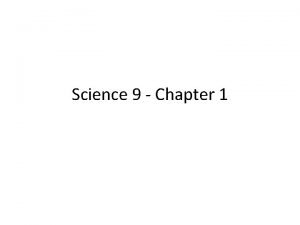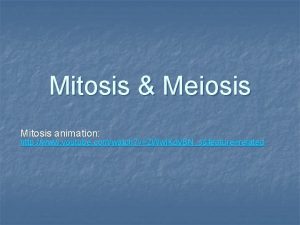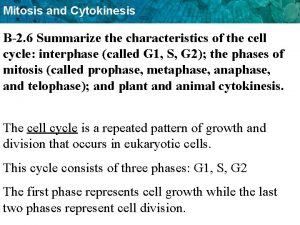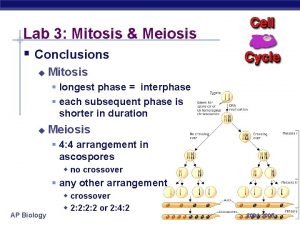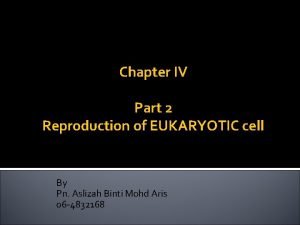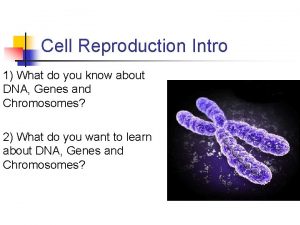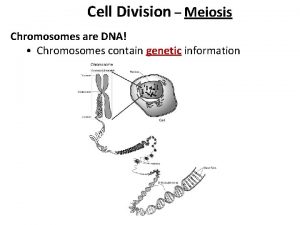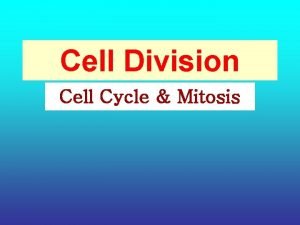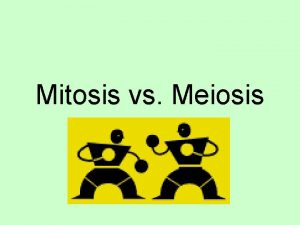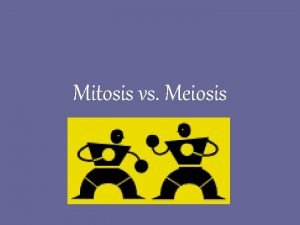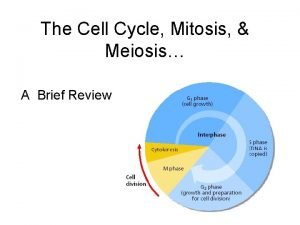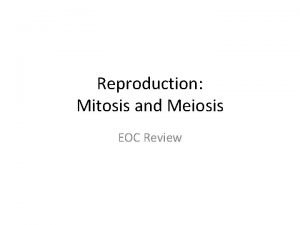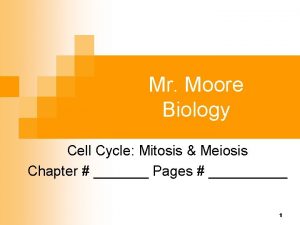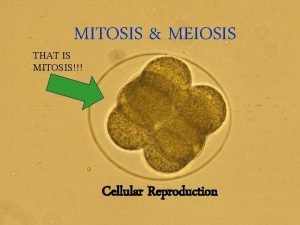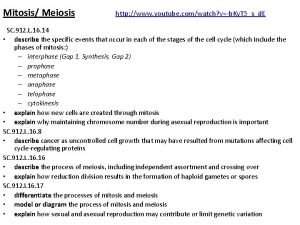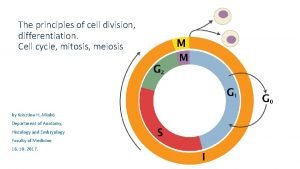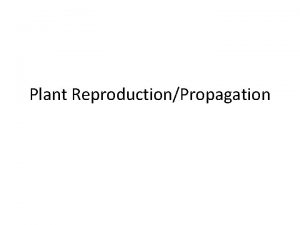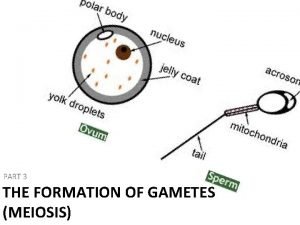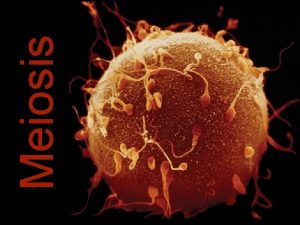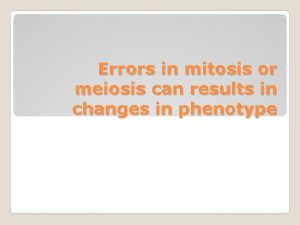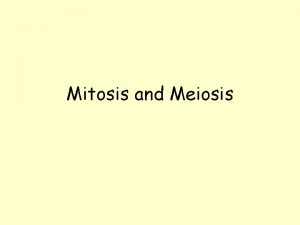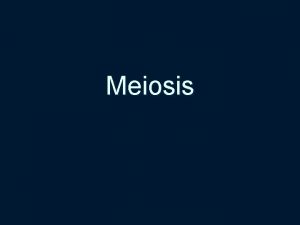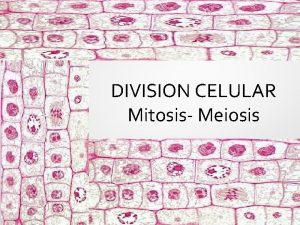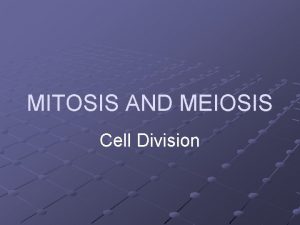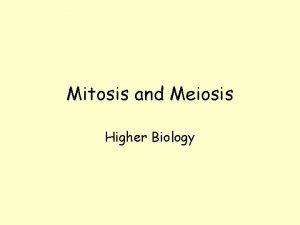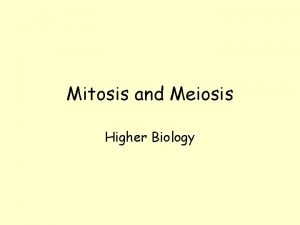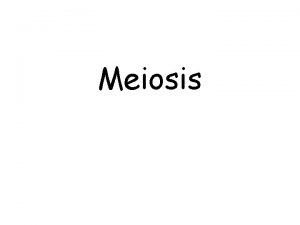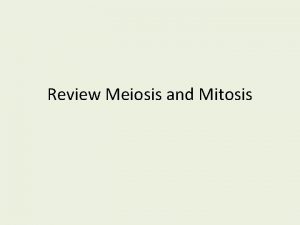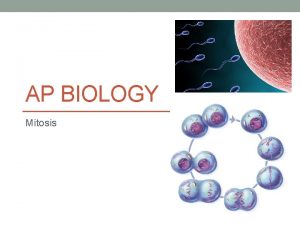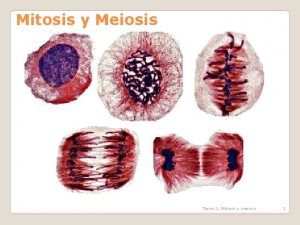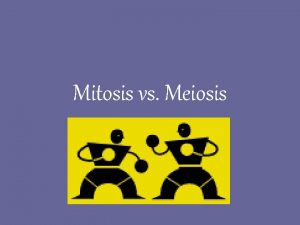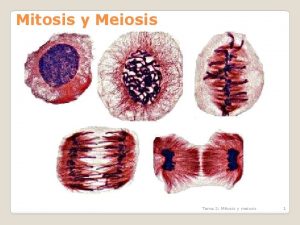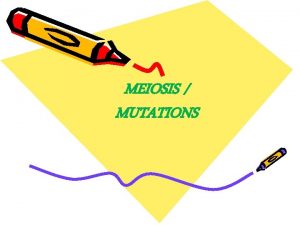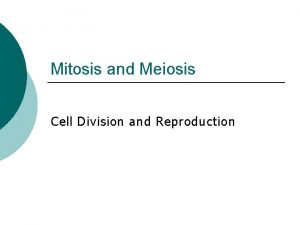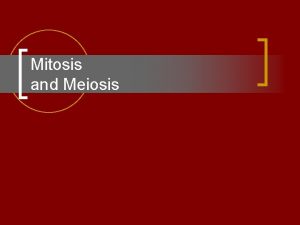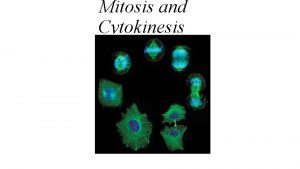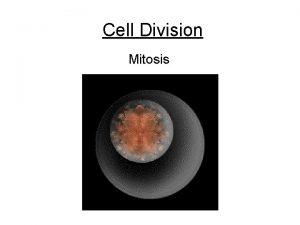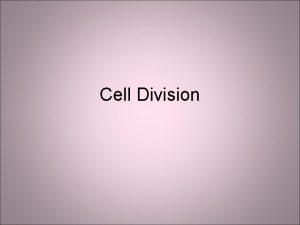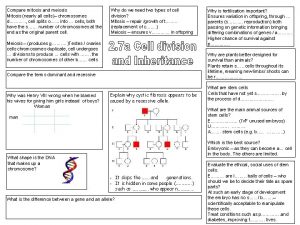Mitosis and Meiosis Cells Division Cells divide for







































- Slides: 39

Mitosis and Meiosis

Cells Division § Cells divide for growth, repair, and reproduction. § There are two ways cell division can happen in humans and most other animals, called mitosis and meiosis. § When a cell divides by way of mitosis, it produces two clones of itself, each with the same number of chromosomes. When a cell divides by way of meiosis, it produces four cells, called gametes. Gametes are more commonly called sperm in males and eggs in females. Unlike in mitosis, the gametes produced by meiosis are not clones of the original cell, because each gamete has exactly half as many chromosomes as the original cell.

Chromosomes • Genetic information is bundled into packages of DNA known as chromosomes. • Prokaryotic chromosomes- Most prokaryotes contain a single, circular DNA that contains all, or nearly all, of the cell’s genetic information. • Eukaryotic cells have much more DNA than prokaryotic cells, and therefore contain multiple chromosomes. Human cells have 46 chromosomes.

4


Prokaryotic Cell Cycle • Prokaryotic cells divide by a form of asexual reproduction known as binary fission, which results in the production of two genetically identical cells.

Eukaryotic Cell Cycle • Consists of 2 parts and 4 phases: • Interphase • G 1 phase • S phase • G 2 phase • Cell Division • M Phase • Mitosis • Cytokinesis

Interphase • G 1 Phase (Gap 1) • Cells do most of their growth during the G 1 phase. • S Phase (Synthesis) • New DNA is synthesized when the chromosomes are replicated. • The cell at the end of S phase contains twice as much DNA as it did at the beginning. • G 2 Phase: Preparing for Cell Division • Shortest of the 3 phases. Organelles required and molecules required for cell division are produced.

Interphase is composed of: • G 1 (gap phase 1) – time of cell growth • S phase – synthesis of DNA (DNA replication) - 2 sister chromatids are produced • G 2 (gap phase 2) – chromosomes condense

M Phase: Cell Division • Produces 2 daughter cells. • The M Phase, takes its name from the process of mitosis. • Cell division occurs in two main stages: • The first stage of the process, division of the cell nucleus, is called mitosis.

Remember PMAT • Prophase • Metaphase • Anaphase • Telophase

Mitosis • A type of cell division that results in two daughter cells each having the same number and kind of chromosomes as the parent nucleus, typical of ordinary tissue growth.

Prophase • During prophase, the genetic material inside the nucleus condenses and the duplicated chromosomes become visible. Outside the nucleolus, a spindle starts to form. • The cell starts to form a spindle, a fan like system of microtubules that will help to separate the duplicated chromosomes. The spindles extend from a region called the centriole. • The centrioles, which were duplicated during interphase, start to move toward opposite ends, or poles, of the cell. • As prophase ends, the chromosomes coil more tightly, the nucleolus disappears, and the nuclear envelope breaks down.

Metaphase • The centromeres of the duplicated chromosomes line up across the center of the cell. Spindle fibers connect the centromere of each chromosome to the two poles of the spindle.

Anaphase • Sister chromatids separate and begin to move apart. Each sister chromatid is now considered an individual chromosome. • During anaphase, the chromosomes separate and move along spindle fibers to opposite ends of the cell. • Anaphase comes to an end when this movement stops and the chromosomes are completely separated into two groups.

Telophase • Final phase of mitosis. • During telophase, the chromosomes, which were distinct and condenses, begin to spread out into a tangle of chromatin. • A nuclear envelope re-forms around each cluster of chromosomes. The spindle breaks apart, and a nucleolus begins to break apart, and a nucleolus becomes visible in each daughter nucleus. • Mitosis is complete

Prophase Anaphase Metaphase Telophase

Cytokinesis • As a result of mitosis, two nuclei, each with a duplicate set of chromosomes, are formed. All that remains to complete the M-phase is the division of the cytoplasm itself, cytokinesis. • Cytokinesis completes the process of cell division- it splits one cell into two. • In animal cells: • Cell membrane is drawn inward • Cleavage furrow forms • In plant cells: • Cell is not flexible enough to draw in. • A cell plate forms between the divided nuclei.

Mitosis

Prophase

Metaphase

Anaphase

Telophase


Meiosis

Meiosis • Meiosis is the process in which the number of chromosomes per cell is cut in half through the separation of homologous chromosomes in a diploid cell. • Diploid cell “two sets”. • The cell of most adult organisms contain two complete sets of chromosomes and two complete sets of genes. • (2 n) in humans 23 pairs or 46 total • Haploid cells “one set” • Some cells contain only a single set of chromosomes and therefore a single set of genes. • (n) gametes or sex cells, in humans 23 chromosomes

Chromosome Pairing • Homologous pair • each chromosome in pair are identical to the other ( carry genes for same trait) • only one pair differs - sex chromosomes X or Y

Meiosis I • Prior to meiosis I, the cell undergoes a round of chromosome replication during interphase. • Each replicated chromosome consists of two identical chromatids joined at the center.

Meiosis I: Prophase I • After interphase I, the begins to divide, and the chromosomes pair up. • In prophase I of meiosis, each replicated chromosome pairs with its corresponding homologous chromosome. • A tetrad is formed, a structure containing four chromatids. • Chromatids cross-over, cross sections of chromatids are exchanged.

Metaphase I and Anaphase I • During metaphase I of meiosis, paired homologous chromosomes line up across the center of the cell. • During anaphase I, spindle fibers pull each homologous chromosome pair toward opposite ends of the cell.

Telophase I and Cytokinesis • When anaphase I is complete, the separated chromosomes cluster at opposite ends of the cell. • The next phase is telophase I, in which a nuclear membrane forms around each cluster of chromosomes. • Cytokinesis forms two new cells.


Meiosis II • Daughter cells undergo a second division; much like mitosis • No additional replication occurs.

Prophase II • The chromosomes – each consisting of two chromatids – become visible. • The chromosomes do not pair to form tetrads. • Spindle fibers form again.

Metaphase II and Anaphase II • During metaphase II, chromosomes line up in the center of the cell. • As the cell enters anaphase, the paired chromatids separate.

Telophase II and Cytokinesis • The result is four haploid daughter cells. • The four daughter cells contains the haploid number (N)- just two chromosomes each.

Similarities between Mitosis and Meiosis • Both are forms of nuclear division • Both involve replication • Both involve disappearance of the nucleus, and nucleolus, nuclear membrane • Both involve formation of spindle fibers

Differences between Mitosis and Meiosis • Meiosis produces daughter cells that have 1/2 the number of chromosomes as the parent. Go from 2 n to 1 n. • Daughter cells produced by meiosis are not genetically identical to one another. • In meiosis cell division takes place twice but replication occurs only once.

Value of Variation • Variation - differences between members of a population. • Meiosis results in random separation of chromosomes in gametes. • Causes diverse populations that over time can be stronger for survival.
 Mitosis and meiosis
Mitosis and meiosis Meiosis
Meiosis Difference between male and female plants
Difference between male and female plants Compare and contrast mitosis and meiosis
Compare and contrast mitosis and meiosis Whats the difference between mitosis and meiosis
Whats the difference between mitosis and meiosis Kesler science answer key
Kesler science answer key Gametes vs somatic cells
Gametes vs somatic cells Comparing mitosis and meiosis
Comparing mitosis and meiosis Mitosis meiosis animation
Mitosis meiosis animation Mitosis purpose
Mitosis purpose Telophase
Telophase Respirometer
Respirometer Meiosis flipbook
Meiosis flipbook Asexual and sexual reproduction venn diagram
Asexual and sexual reproduction venn diagram Chromosome sets (=n) in mitosis and meiosis
Chromosome sets (=n) in mitosis and meiosis Characteristics of mitosis and meiosis
Characteristics of mitosis and meiosis Number of chromosomes in meiosis and mitosis
Number of chromosomes in meiosis and mitosis Chromosome sets (=n) in mitosis and meiosis
Chromosome sets (=n) in mitosis and meiosis Difference between meiosis 1 and 2
Difference between meiosis 1 and 2 Anapjase
Anapjase Tetrad meiosis
Tetrad meiosis Mitosis vs meiosis double bubble compare and contrast
Mitosis vs meiosis double bubble compare and contrast Chromosome/mitosis/meiosis review answer key
Chromosome/mitosis/meiosis review answer key Mitosis jeopardy
Mitosis jeopardy Meiosis and mitosis images
Meiosis and mitosis images Prophase cell cycle
Prophase cell cycle The american buffalo has cells containing 60 chromosomes
The american buffalo has cells containing 60 chromosomes Mitosis and meiosis
Mitosis and meiosis Put these in order
Put these in order Independent assortment of chromosomes
Independent assortment of chromosomes Synapsis and crossing over
Synapsis and crossing over Concept map comparing mitosis and meiosis
Concept map comparing mitosis and meiosis Importance of mitosis
Importance of mitosis When does crossing over occur
When does crossing over occur Mitosis
Mitosis Cell cycle jeopardy
Cell cycle jeopardy Mitosis and meiosis differences
Mitosis and meiosis differences Mitosis and meiosis diagram
Mitosis and meiosis diagram Concept map mitosis and meiosis
Concept map mitosis and meiosis Edward syndrome
Edward syndrome


